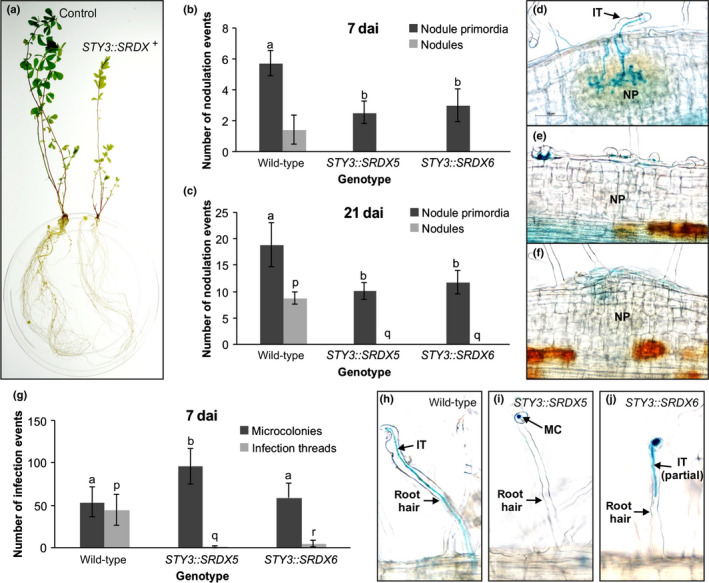Fig. 6.

Transgenic Lotus japonicus plants carrying the LjNF‐YA1Pro:STY3::SRDX construct do not form nodules. (a) Images, taken 28 d after inoculation (dai) with Mesorhizobium loti, of representative, fully transgenic T0 L. japonicus plants carrying either empty vector (control), or the same vector containing the LjNF‐YA1Pro:STY3::SRDX transgene (STY3::SRDX +). (b, c) Scores of nodulation events at 7 (b) and 21 dai (c) with M. loti, from two independent L. japonicus T1 populations (STY3::SRDX5 and STY3::SRDX6) segregating the LjNF‐YA1Pro:STY3::SRDX transgene. Note that ‘wild‐type’ denotes T1 segregants without the transgene. (d–f) Representative images of wild‐type nodule primordia (NP) (d) and those formed by transgenic plants carrying the LjNF‐YA1Pro:STY3::SRDX transgene (e, f). The image in (e) shows a typical, small NP event while panel (f) represents an infrequent, larger NP that forms a visible bump at the root surface. (g) Scores of infection events (i.e. microcolonies and epidermal infection threads) in L. japonicus T1 plants that either lack (wild‐type) or carry the LjNF‐YA1Pro:STY3::SRDX transgene. The scores represent means ± 95% confidence intervals. Statistical groupings, reflected by the same letters, have been determined separately for each of the two infection event categories using one‐way ANOVA with Tukey’s honestly significant difference post hoc test. (h–j) Representative images of epidermal infection events in the wild‐type (h) and the transgene‐containing (STY3::SRDX5) T1 plants (i, j) are shown. MC, microcolony; IT, epidermal infection thread; IT (partial), IT that was terminated within the root hair shaft.
